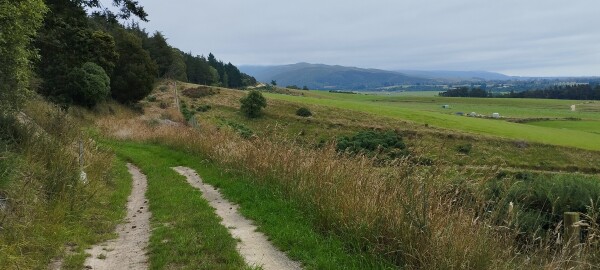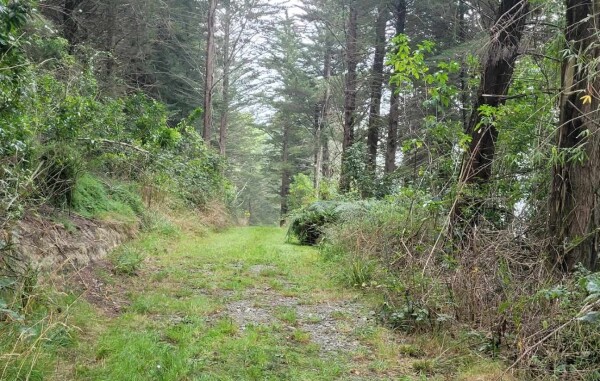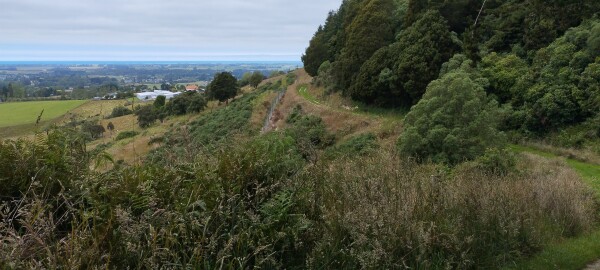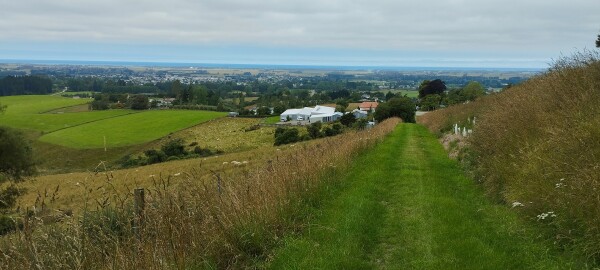New Walkway Ko Te Ara a Taane a “Revelation”
A new public Walkway boasting views worthy of a forest god is the latest win for a South Canterbury project turning bare land into bird-filled bush.
Ko te Ara a Taane, an approximately two-kilometre, gently undulating trail alongside regenerating remnants of ancient forest in Waimate’s Point Bush Ecosanctuary, was gazetted in January as a public Walkway.
The 94-hectare ecosanctuary and its new Walkway perch in the hills adjacent to Waimate’s well-known White Horse monument (a homage to the region’s pioneering draught horses).
The location commands outstanding views from the Pacific Ocean to the Southern Alps, the Ecosanctuary’s Gary Dennison says.
“You can see towards Mount Cook, Mount Horrible, from Fairlie and Pleasant Point up to Mt Hutt and the Rakaia Gorge. It’s very pretty… you never really get used to it; it changes every day.”

Photo: Mary-Anne Baxter
The name, meaning the Walkway of Taane (who, in Māori lore, is god of the forest) was given by the head of Te Rūnanga o Waihao, the Ngai Tahu rohe within which the Point Bush Ecosanctuary lies.
Tewera King, te Upokorūnanga o Waihao, said the name was apt for an ecosanctuary.
“This is a walkway through the world of Taane.”
King says that bestowing the name was also an acknowledgment of the Rūnanga’s deep connection with their territory, which extends from the Pareora River to the Waitaki River, and into the Mackenzie country.
“We’re a proud but humble people. Our roots into the whenua there go real deep. And even though most of the whānau no longer live there, the ones who are from Waihao are damn proud of where they are from.”
The new Walkway and the whole ecosanctuary were great, but he wishes such efforts weren’t so isolated.
“My biggest fear is that sites like this will one day be the only places where you will see the bush as close to its natural state as how it used to be in this whole area.”

Photo: Gary Dennison
Gary Dennison considers the name “very appropriate”.
“One of the original property titles, at one end of the property, was a Māori reserve — a source of medicinal plants, berries and so on…so this was always a pathway to natural resources.”
Gary takes satisfaction from the fact the new Walkway is along a strip of land that was a legal road before it was stopped in the 1990s.
It runs between, on one side, open farmland above those exquisite views, and on the other, an extensive network of walking and mountain-biking tracks through the sanctuary’s maturing, birdsong-filled bush.
Trees in the sanctuary include, mataī, kahikatea, kо̄whai and native fuchsia (kōtukutuku), and among the birds are korimako (bellbird), tūī, kererū, pīwakawaka (fantail) and titipounamu (rifleman).
Ko te Ara a Taane is the first of three new Walkway easements planned for the sanctuary. They will create a loop, and link to the White Horse monument path.
Bare land to bush and birds
Gary and his wife Ann began restoring the almost totally “grazed out” land when they first bought it, while living overseas around thirty years ago.
“There were small patches of mānuka and tōtara, but it was pretty bare territory.”
Since then, as well as closing off the land from grazing and planting macrocarpa and Douglas fir for a planned commercial forestry enterprise, they have planted other areas in tōtara, kahikatea and other native trees and plants.
As it turned out, most of the introduced trees were wiped out in a big north-westerly storm. Those that are left will eventually be harvested and the money ploughed back into further native replanting.
Gary says legalising a permanent public Walkway through a fully-fledged forest, which developed from these early efforts, has been rewarding:
“From virtually nothing, there’s now full native canopy in some areas, quite big tōtara… To be alive to actually experience the end results of your efforts is a great revelation.”

Photo: Mary-Anne Baxter
When they moved permanently back to Waimate from overseas in 2007, the couple began restoration efforts in earnest.
In 2019 the Dennisons decided to put the block into the ownership of a trust so that it would be protected as a community asset in perpetuity, creating the Point Bush Ecosanctuary Restoration Trust.
They raised money to build a predator-proof fence right around it and began trapping out the pests inside. Wallabies were eliminated about a year ago, and they are closing in on the remaining mustelids, rats, possums and other invaders.
The entire block is now protected under Queen Elizabeth II National Trust conservation covenants.
Gary says that from the start, it didn’t take long for nature to reassert itself.
“Suddenly tūī started appearing, and we went ooh, where did they come from? Now we’re getting kākā appearing, and aiming for saddlebacks, robins.
“When you suddenly realise you’ve changed your whole environment – the whole understory is undisturbed, you go into the bush now and it’s just alive with birdsong. It’s fantastic.”
Fish, firearms and fairness
The couple developed their giving instinct while Gary worked as an aviation advisor and aeronautical telecommunications specialist with the United Nations in countries such as Iraq, Libya, Pacific nations and Thailand.
Sharing fresh Nile perch he’d caught with child soldiers in Uganda was the kind of thing that marked him, Gary says.
“When you’re getting challenged by a nine-year-old with an AK47, you realise he has a different understanding of what’s fair and equitable… you need to develop trust. You’re not take, take, take, you need to give… You just try and help.”
That approach continued once they returned to Waimate.
“We had this land. Do we develop it commercially, and then what? Or return it to the community in a better state than we received it in?
“When you’re walking through a native tree forest that you’ve regenerated… it’s quite a special recognition of what can be achieved when everyone is pulling in the same direction.”

Photo: Mary-Anne Baxter
Gary has long been involved with another Waimate project with a forest regeneration aspect, Bushtown, and sees parallels with what he envisions for the future of the ecosanctuary.
“People donated money to plant a tree there, and some of them are now 10 metres high. It gives you a special pat on the back… We’re not going to be around when the real back-slapping happens [with Point Bush]. But unless someone pushes the start button, nothing happens. We decided to push that start button.”
- The new Ko Te Ara a Taane Walkway starts from the main entrance to Point Bush Ecosanctuary at the end of Point Bush Road, about 3km from Waimate. Entrance is free. More information: www.pointbush.co.nz

